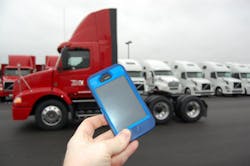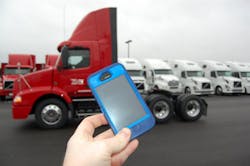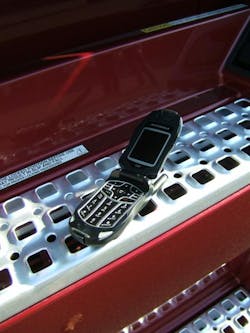"We know drivers want to be connected while driving, but how do we safely give drivers what they want?" noted Doug Patton, senior vice president of engineering at global automotive supplier Denso International America, Inc.
"That’s why we need to evaluate driver workload – but currently there is no quantifiable and objective metrology model in place. Not to mention, there's a high price tag attached to researching and developing something like this,” he added. “With that said, forming a consortium will help reach the goal of establishing a common methodology."
That’s why Denso has joined forces with the Massachusetts Institute of Technology (MIT) AgeLab and Touchstone Evaluations to create a consortium dubbed the Advanced Human Factors Evaluator for Automotive Distraction (AHEAD) to develop new perspectives and methodologies regarding distractive driving.
[For example, take a look at the MIT AgeLab’s research into how typefaces used to display information can affect the driver.]
Denso’s Patton noted Honda R&D Americas, Inc., Subaru Research & Development and Jaguar Land Rover also are joining the program as initial partners, while discussions with other global automakers and portable electronics suppliers are ongoing.
He added that this new consortium aims to bring together leading researchers, automakers and suppliers to take a fresh look at methods to reliably and repeatedly assess the demands associated with in-vehicle interactions. Further, this work aims to provide the auto industry with an evaluation platform that better supports driver safety as the potential for automotive human-machine interface (HMI) complexity increases.
Current evaluation methods for HMI technologies are primarily based upon criteria developed before the advent of modern integrated technologies such as voice interfaces, touch screens and multi-function controllers, explained Steven Feit, chief engineer of infotainment development at Honda R&D Americas.
“Perhaps most importantly, the evaluation methods utilized to date don't consider the tradeoffs that exist as demand is moved between modalities such as vision, touch, sound, ‘haptics’ [which means nonverbal communication involving touch] , gesture and cognition,” he said.
[Honda will most no doubt tap into its many research resources, such as its driver simulator developed in partnership with The Ohio State University shown below, as part of its work with AHEAD.]
Thus AHEAD’s research aims to make early stage prototype evaluations more feasible where design changes can be more effectively achieved, emphasized Feit, in contrast to evaluations that frequently take place later in the vehicle development process.
"Establishing a common understanding of human performance of in-vehicle tasks that can distract drivers from the primary task of operating the vehicle safely is an important goal for the industry," he noted. "This type of research and collaboration will lead to new automotive innovations and the inclusion of exciting features and consumer technology that can be operated safely in vehicles."
Eventually, AHEAD hopes to create a quantifiable objective evaluation “toolkit” for the automotive industry to help support new HMI development; one that will improve the effectiveness and reliability of data, helping manufactures and portable electronics suppliers offer intuitive, convenient and safe interfaces to the consumer while more effectively meeting industry and governmental guidelines.
"Physiological measures complement traditional visual attention and performance measures to provide a more complete picture of the interacting demands of modern HMI,” added Bryan Reimer, a research scientist in the MIT AgeLab, the associate director of the New England University Transportation Center at MIT and the MIT technical lead for AHEAD. “We hope to create a ‘multi-dimensional’ assessment by holistically combining physiological, visual attention and performance measures as part of HMI evaluation.”
Near-term, however, a lot of work continues upon the issue of how to eliminate or at least reduce driver distractions cause by smart phones and other personalized electronic devices while a vehicle is in operation.
Take Aegis Mobility, for one, which recently release a “safe driving” version of its FleetSafer software package compatible with the Apple iOS operating system to help enforce corporate “safe driving” policies while employees are behind the wheel, mitigating the risks and costs associated with distracted driving.
Paul Zimmerman, CEO of Aegis, added that In addition to Apple iOS, FleetSafer is also available on BlackBerry and Android devices and on Kyocera feature phones with Sprint Direct Connect.
“Employees who use mobile phones or tablets while driving are not only a danger to themselves; they also pose a significant risk and liability to their employer,” he explained, adding that FleetSafer is also equipped with a patent-pending method that automatically places the employee’s mobile device in “safe mode” when driving is sensed that also prevents a driver from evading the “safe mode” while driving, excluding emergency calls.
The reason more such software systems for smart phones and other devices are coming to the fore is that the distractions they pose to drivers can be catastrophic, stressed John Ulczycki, vice president of strategic initiatives at the National Safety Council (NSC).
“Thousands die each year in car crashes involving distracted drivers,” he said “Drivers who are talking on handheld or hands-free cell phones are four times as likely to be involved in a crash. Cell phone distracted drivers miss seeing up to 50% of their driving environment and have significantly delayed reaction times [and] NSC also estimates one in 4 car crashes involve cell phone use.”Of course, it gets a little more complicated on the commercial vehicle side of the ledger, David Coleman, executive VP of strategy and market development for Cellcontrol told me in an interview late last year.
“How you handle ‘slip seating’ of commercial drivers, for example, is one complication,” he told me. “That’s why we’ve developed ‘DriverID’ technology, which creates ‘zones’ around the driver and passenger spaces with in the commercial truck cab.”
DriveID is a solar-powered, windshield-mounted, cable-free, device that identifies the driver and distinguishes policy enforcement between the driver and accompanying passengers. That way, Coleman explained, in a team driver operation, the off-duty driver can use their phone in the cab while the vehicle is moving but the driver cannot.
Cellcontrol’s system is also now available for Apple’s iPhone, deferring text, email, web-surfing, etc., when a vehicle is in motion.
“We’re making smartphones smarter by empowering users to control their iPhone at the feature level when a vehicle is in motion,” noted Rob Guba, CEO and co-founder of Cellcontrol. “Personal responsibility, government regulation and law enforcement can only do so much to curb a driver’s desire to look at the phone so we try to get to the heart of the problem. We keep phones quiet by putting the device on virtual do-not-disturb and temporarily disabling mobile phone features that cause distraction in the first place.”
Joe Breaux, chief technology officer and another co-founder of Cellcontrol, added that Apple's security architecture “made building a driver distraction product for iOS a challenge,” since developers are prevented from building applications that interfere with the use of other iOS applications. So the solution’s been to use Cellcontrol’s hardware, rather than an iOS application, to perform what he dubbed “policy enforcement.”
“It keeps drivers from being distracted by texts and email while simultaneously allowing the safe use of iPhone features like Siri,” he explained. “Moreover, the solution provides a policy module, which allows administrators to limit all, or just some, of a driver’s iPhone features.”
Thus when vehicle motion is detected, Cellcontrol instantly enforces the specified driver policy – at the phone feature level – enabling use of, or disabling, specific iPhone features, Breaux said. “We also offer parents of teen drivers, fleet managers, and individuals who do not want to be disturbed while driving, the ability to easily manage how an iPhone functions in a vehicle,” he added.
Just goes to show that the technological work going to help reduced distracted driving certainly isn’t slowing up, now or for the foreseeable future.


